Literature Review: Mixed Reality Visualization in Image Guided Surgery
VerifiedAdded on 2024/06/28
|80
|9595
|460
Literature Review
AI Summary
This document presents a literature review focusing on the application of mixed reality visualization techniques in image-guided surgery. It includes APA-formatted references and citations, journal rankings, and keywords for each reviewed paper. The review analyzes various solutions, techniques, algorithms, models, tools, and frameworks used in the field, detailing their goals, problems addressed, components, and processes. It critically evaluates the advantages and disadvantages of each approach, along with validation criteria, input/output data, and the research's value to the project. The document also features a review of a paper on artificial intelligence in healthcare, discussing its techniques like deep learning and machine learning, and their impact on medical decision-making. The aim is to provide a comprehensive overview of current research and identify potential areas for improvement and innovation in the domain of image-guided surgery using mixed reality visualization. Desklib provides this and many other solved assignments to help students.
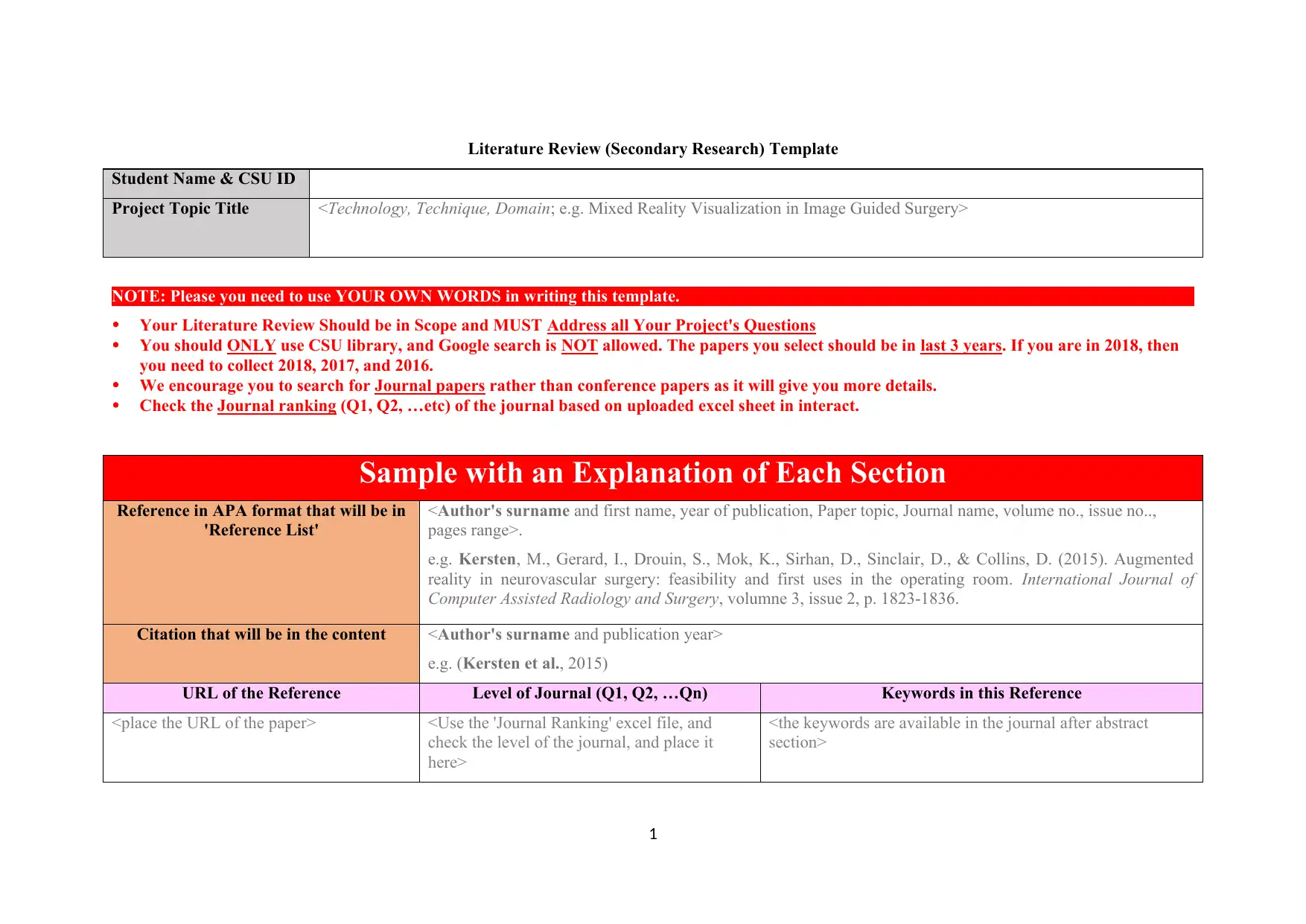
Literature Review (Secondary Research) Template
Student Name & CSU ID
Project Topic Title <Technology, Technique, Domain; e.g. Mixed Reality Visualization in Image Guided Surgery>
NOTE: Please you need to use YOUR OWN WORDS in writing this template.
Your Literature Review Should be in Scope and MUST Address all Your Project's Questions
You should ONLY use CSU library, and Google search is NOT allowed. The papers you select should be in last 3 years. If you are in 2018, then
you need to collect 2018, 2017, and 2016.
We encourage you to search for Journal papers rather than conference papers as it will give you more details.
Check the Journal ranking (Q1, Q2, …etc) of the journal based on uploaded excel sheet in interact.
Sample with an Explanation of Each Section
Reference in APA format that will be in
'Reference List'
<Author's surname and first name, year of publication, Paper topic, Journal name, volume no., issue no..,
pages range>.
e.g. Kersten, M., Gerard, I., Drouin, S., Mok, K., Sirhan, D., Sinclair, D., & Collins, D. (2015). Augmented
reality in neurovascular surgery: feasibility and first uses in the operating room. International Journal of
Computer Assisted Radiology and Surgery, volumne 3, issue 2, p. 1823-1836.
Citation that will be in the content <Author's surname and publication year>
e.g. (Kersten et al., 2015)
URL of the Reference Level of Journal (Q1, Q2, …Qn) Keywords in this Reference
<place the URL of the paper> <Use the 'Journal Ranking' excel file, and
check the level of the journal, and place it
here>
<the keywords are available in the journal after abstract
section>
1
Student Name & CSU ID
Project Topic Title <Technology, Technique, Domain; e.g. Mixed Reality Visualization in Image Guided Surgery>
NOTE: Please you need to use YOUR OWN WORDS in writing this template.
Your Literature Review Should be in Scope and MUST Address all Your Project's Questions
You should ONLY use CSU library, and Google search is NOT allowed. The papers you select should be in last 3 years. If you are in 2018, then
you need to collect 2018, 2017, and 2016.
We encourage you to search for Journal papers rather than conference papers as it will give you more details.
Check the Journal ranking (Q1, Q2, …etc) of the journal based on uploaded excel sheet in interact.
Sample with an Explanation of Each Section
Reference in APA format that will be in
'Reference List'
<Author's surname and first name, year of publication, Paper topic, Journal name, volume no., issue no..,
pages range>.
e.g. Kersten, M., Gerard, I., Drouin, S., Mok, K., Sirhan, D., Sinclair, D., & Collins, D. (2015). Augmented
reality in neurovascular surgery: feasibility and first uses in the operating room. International Journal of
Computer Assisted Radiology and Surgery, volumne 3, issue 2, p. 1823-1836.
Citation that will be in the content <Author's surname and publication year>
e.g. (Kersten et al., 2015)
URL of the Reference Level of Journal (Q1, Q2, …Qn) Keywords in this Reference
<place the URL of the paper> <Use the 'Journal Ranking' excel file, and
check the level of the journal, and place it
here>
<the keywords are available in the journal after abstract
section>
1
Paraphrase This Document
Need a fresh take? Get an instant paraphrase of this document with our AI Paraphraser
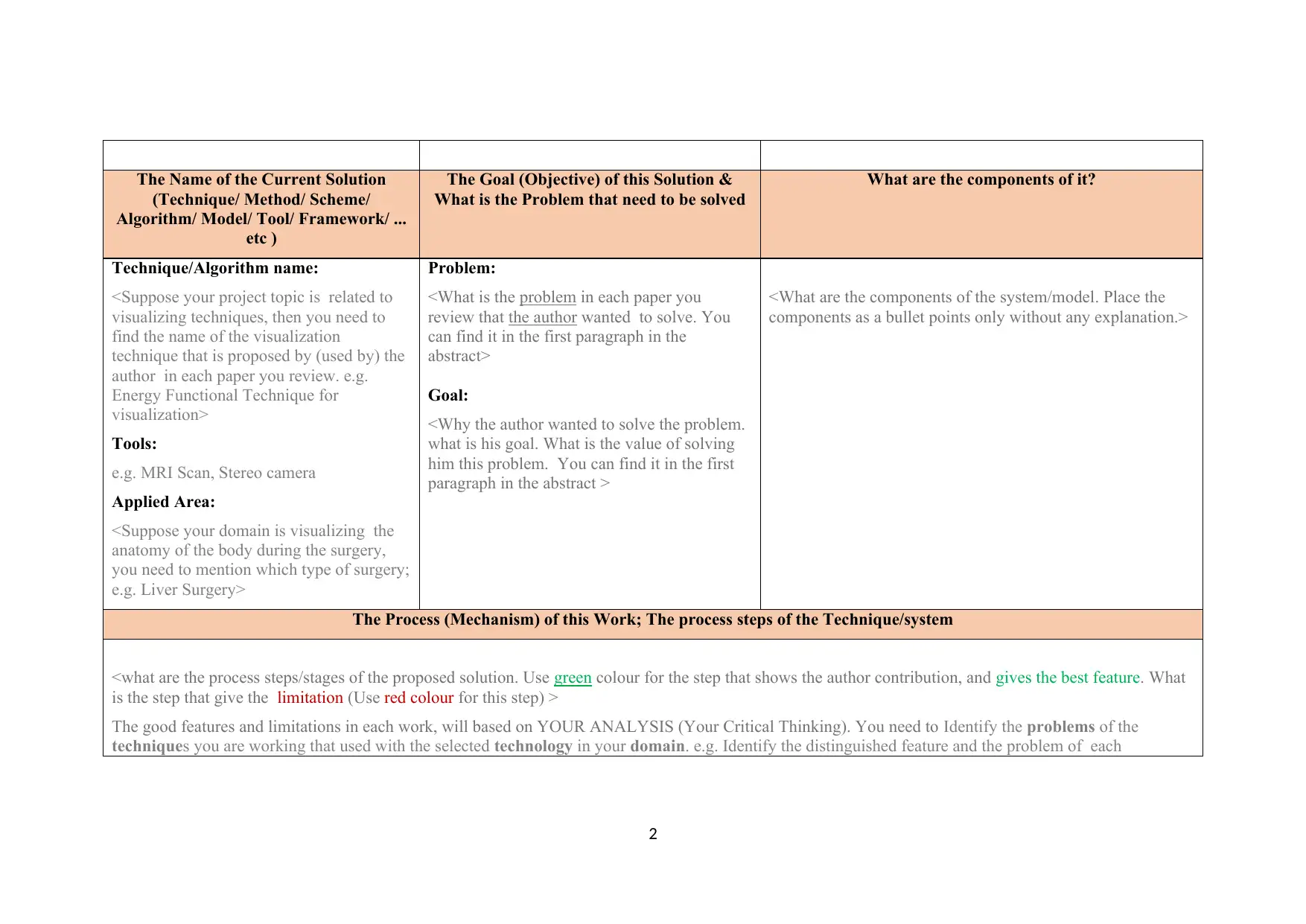
The Name of the Current Solution
(Technique/ Method/ Scheme/
Algorithm/ Model/ Tool/ Framework/ ...
etc )
The Goal (Objective) of this Solution &
What is the Problem that need to be solved
What are the components of it?
Technique/Algorithm name:
<Suppose your project topic is related to
visualizing techniques, then you need to
find the name of the visualization
technique that is proposed by (used by) the
author in each paper you review. e.g.
Energy Functional Technique for
visualization>
Tools:
e.g. MRI Scan, Stereo camera
Applied Area:
<Suppose your domain is visualizing the
anatomy of the body during the surgery,
you need to mention which type of surgery;
e.g. Liver Surgery>
Problem:
<What is the problem in each paper you
review that the author wanted to solve. You
can find it in the first paragraph in the
abstract>
Goal:
<Why the author wanted to solve the problem.
what is his goal. What is the value of solving
him this problem. You can find it in the first
paragraph in the abstract >
<What are the components of the system/model. Place the
components as a bullet points only without any explanation.>
The Process (Mechanism) of this Work; The process steps of the Technique/system
<what are the process steps/stages of the proposed solution. Use green colour for the step that shows the author contribution, and gives the best feature. What
is the step that give the limitation (Use red colour for this step) >
The good features and limitations in each work, will based on YOUR ANALYSIS (Your Critical Thinking). You need to Identify the problems of the
techniques you are working that used with the selected technology in your domain. e.g. Identify the distinguished feature and the problem of each
2
(Technique/ Method/ Scheme/
Algorithm/ Model/ Tool/ Framework/ ...
etc )
The Goal (Objective) of this Solution &
What is the Problem that need to be solved
What are the components of it?
Technique/Algorithm name:
<Suppose your project topic is related to
visualizing techniques, then you need to
find the name of the visualization
technique that is proposed by (used by) the
author in each paper you review. e.g.
Energy Functional Technique for
visualization>
Tools:
e.g. MRI Scan, Stereo camera
Applied Area:
<Suppose your domain is visualizing the
anatomy of the body during the surgery,
you need to mention which type of surgery;
e.g. Liver Surgery>
Problem:
<What is the problem in each paper you
review that the author wanted to solve. You
can find it in the first paragraph in the
abstract>
Goal:
<Why the author wanted to solve the problem.
what is his goal. What is the value of solving
him this problem. You can find it in the first
paragraph in the abstract >
<What are the components of the system/model. Place the
components as a bullet points only without any explanation.>
The Process (Mechanism) of this Work; The process steps of the Technique/system
<what are the process steps/stages of the proposed solution. Use green colour for the step that shows the author contribution, and gives the best feature. What
is the step that give the limitation (Use red colour for this step) >
The good features and limitations in each work, will based on YOUR ANALYSIS (Your Critical Thinking). You need to Identify the problems of the
techniques you are working that used with the selected technology in your domain. e.g. Identify the distinguished feature and the problem of each
2
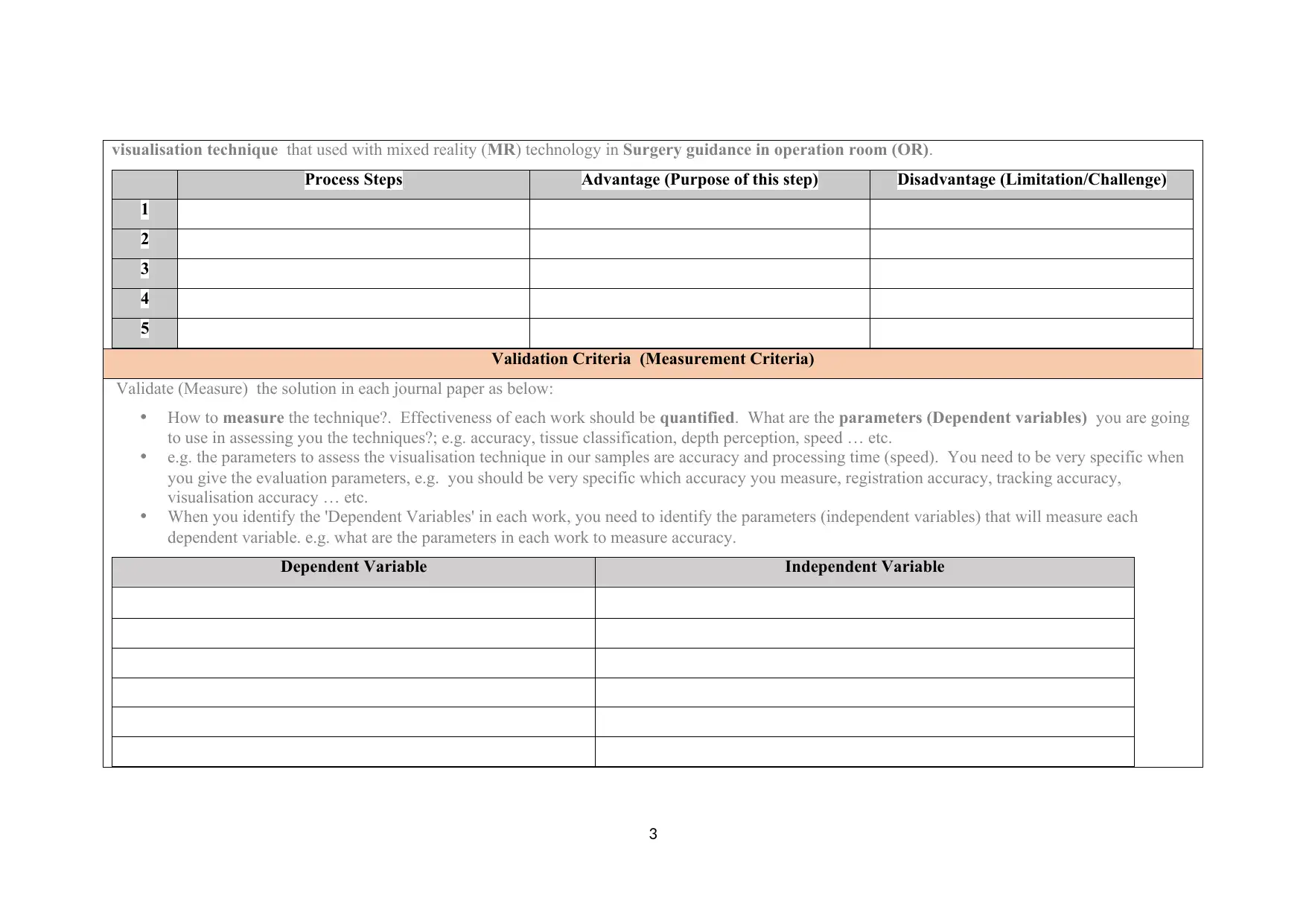
visualisation technique that used with mixed reality (MR) technology in Surgery guidance in operation room (OR).
Process Steps Advantage (Purpose of this step) Disadvantage (Limitation/Challenge)
1
2
3
4
5
Validation Criteria (Measurement Criteria)
Validate (Measure) the solution in each journal paper as below:
How to measure the technique?. Effectiveness of each work should be quantified. What are the parameters (Dependent variables) you are going
to use in assessing you the techniques?; e.g. accuracy, tissue classification, depth perception, speed … etc.
e.g. the parameters to assess the visualisation technique in our samples are accuracy and processing time (speed). You need to be very specific when
you give the evaluation parameters, e.g. you should be very specific which accuracy you measure, registration accuracy, tracking accuracy,
visualisation accuracy … etc.
When you identify the 'Dependent Variables' in each work, you need to identify the parameters (independent variables) that will measure each
dependent variable. e.g. what are the parameters in each work to measure accuracy.
Dependent Variable Independent Variable
3
Process Steps Advantage (Purpose of this step) Disadvantage (Limitation/Challenge)
1
2
3
4
5
Validation Criteria (Measurement Criteria)
Validate (Measure) the solution in each journal paper as below:
How to measure the technique?. Effectiveness of each work should be quantified. What are the parameters (Dependent variables) you are going
to use in assessing you the techniques?; e.g. accuracy, tissue classification, depth perception, speed … etc.
e.g. the parameters to assess the visualisation technique in our samples are accuracy and processing time (speed). You need to be very specific when
you give the evaluation parameters, e.g. you should be very specific which accuracy you measure, registration accuracy, tracking accuracy,
visualisation accuracy … etc.
When you identify the 'Dependent Variables' in each work, you need to identify the parameters (independent variables) that will measure each
dependent variable. e.g. what are the parameters in each work to measure accuracy.
Dependent Variable Independent Variable
3
⊘ This is a preview!⊘
Do you want full access?
Subscribe today to unlock all pages.

Trusted by 1+ million students worldwide
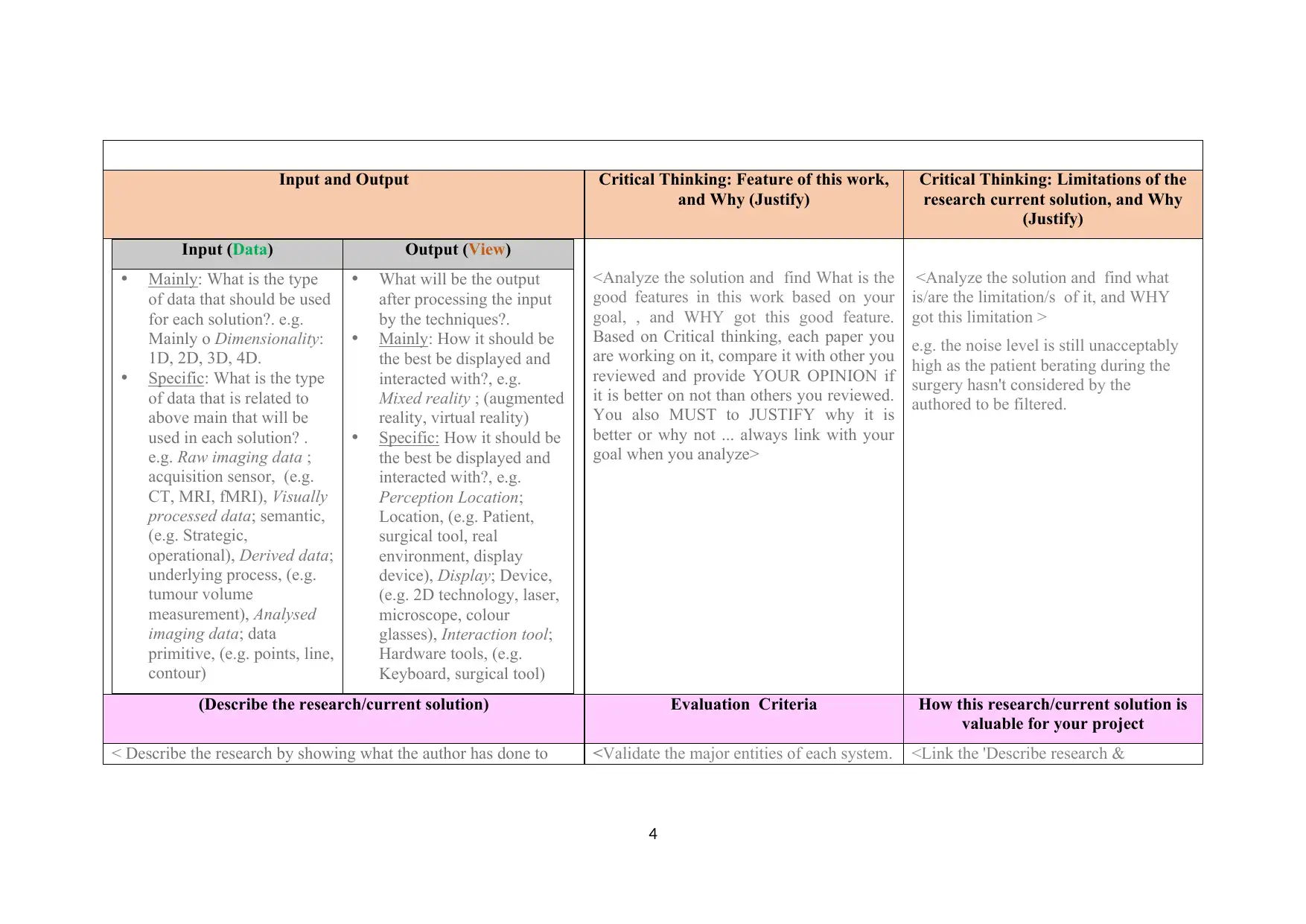
Input and Output Critical Thinking: Feature of this work,
and Why (Justify)
Critical Thinking: Limitations of the
research current solution, and Why
(Justify)
Input (Data) Output (View)
Mainly: What is the type
of data that should be used
for each solution?. e.g.
Mainly o Dimensionality:
1D, 2D, 3D, 4D.
Specific: What is the type
of data that is related to
above main that will be
used in each solution? .
e.g. Raw imaging data ;
acquisition sensor, (e.g.
CT, MRI, fMRI), Visually
processed data; semantic,
(e.g. Strategic,
operational), Derived data;
underlying process, (e.g.
tumour volume
measurement), Analysed
imaging data; data
primitive, (e.g. points, line,
contour)
What will be the output
after processing the input
by the techniques?.
Mainly: How it should be
the best be displayed and
interacted with?, e.g.
Mixed reality ; (augmented
reality, virtual reality)
Specific: How it should be
the best be displayed and
interacted with?, e.g.
Perception Location;
Location, (e.g. Patient,
surgical tool, real
environment, display
device), Display; Device,
(e.g. 2D technology, laser,
microscope, colour
glasses), Interaction tool;
Hardware tools, (e.g.
Keyboard, surgical tool)
<Analyze the solution and find What is the
good features in this work based on your
goal, , and WHY got this good feature.
Based on Critical thinking, each paper you
are working on it, compare it with other you
reviewed and provide YOUR OPINION if
it is better on not than others you reviewed.
You also MUST to JUSTIFY why it is
better or why not ... always link with your
goal when you analyze>
<Analyze the solution and find what
is/are the limitation/s of it, and WHY
got this limitation >
e.g. the noise level is still unacceptably
high as the patient berating during the
surgery hasn't considered by the
authored to be filtered.
(Describe the research/current solution) Evaluation Criteria How this research/current solution is
valuable for your project
< Describe the research by showing what the author has done to <Validate the major entities of each system. <Link the 'Describe research &
4
and Why (Justify)
Critical Thinking: Limitations of the
research current solution, and Why
(Justify)
Input (Data) Output (View)
Mainly: What is the type
of data that should be used
for each solution?. e.g.
Mainly o Dimensionality:
1D, 2D, 3D, 4D.
Specific: What is the type
of data that is related to
above main that will be
used in each solution? .
e.g. Raw imaging data ;
acquisition sensor, (e.g.
CT, MRI, fMRI), Visually
processed data; semantic,
(e.g. Strategic,
operational), Derived data;
underlying process, (e.g.
tumour volume
measurement), Analysed
imaging data; data
primitive, (e.g. points, line,
contour)
What will be the output
after processing the input
by the techniques?.
Mainly: How it should be
the best be displayed and
interacted with?, e.g.
Mixed reality ; (augmented
reality, virtual reality)
Specific: How it should be
the best be displayed and
interacted with?, e.g.
Perception Location;
Location, (e.g. Patient,
surgical tool, real
environment, display
device), Display; Device,
(e.g. 2D technology, laser,
microscope, colour
glasses), Interaction tool;
Hardware tools, (e.g.
Keyboard, surgical tool)
<Analyze the solution and find What is the
good features in this work based on your
goal, , and WHY got this good feature.
Based on Critical thinking, each paper you
are working on it, compare it with other you
reviewed and provide YOUR OPINION if
it is better on not than others you reviewed.
You also MUST to JUSTIFY why it is
better or why not ... always link with your
goal when you analyze>
<Analyze the solution and find what
is/are the limitation/s of it, and WHY
got this limitation >
e.g. the noise level is still unacceptably
high as the patient berating during the
surgery hasn't considered by the
authored to be filtered.
(Describe the research/current solution) Evaluation Criteria How this research/current solution is
valuable for your project
< Describe the research by showing what the author has done to <Validate the major entities of each system. <Link the 'Describe research &
4
Paraphrase This Document
Need a fresh take? Get an instant paraphrase of this document with our AI Paraphraser
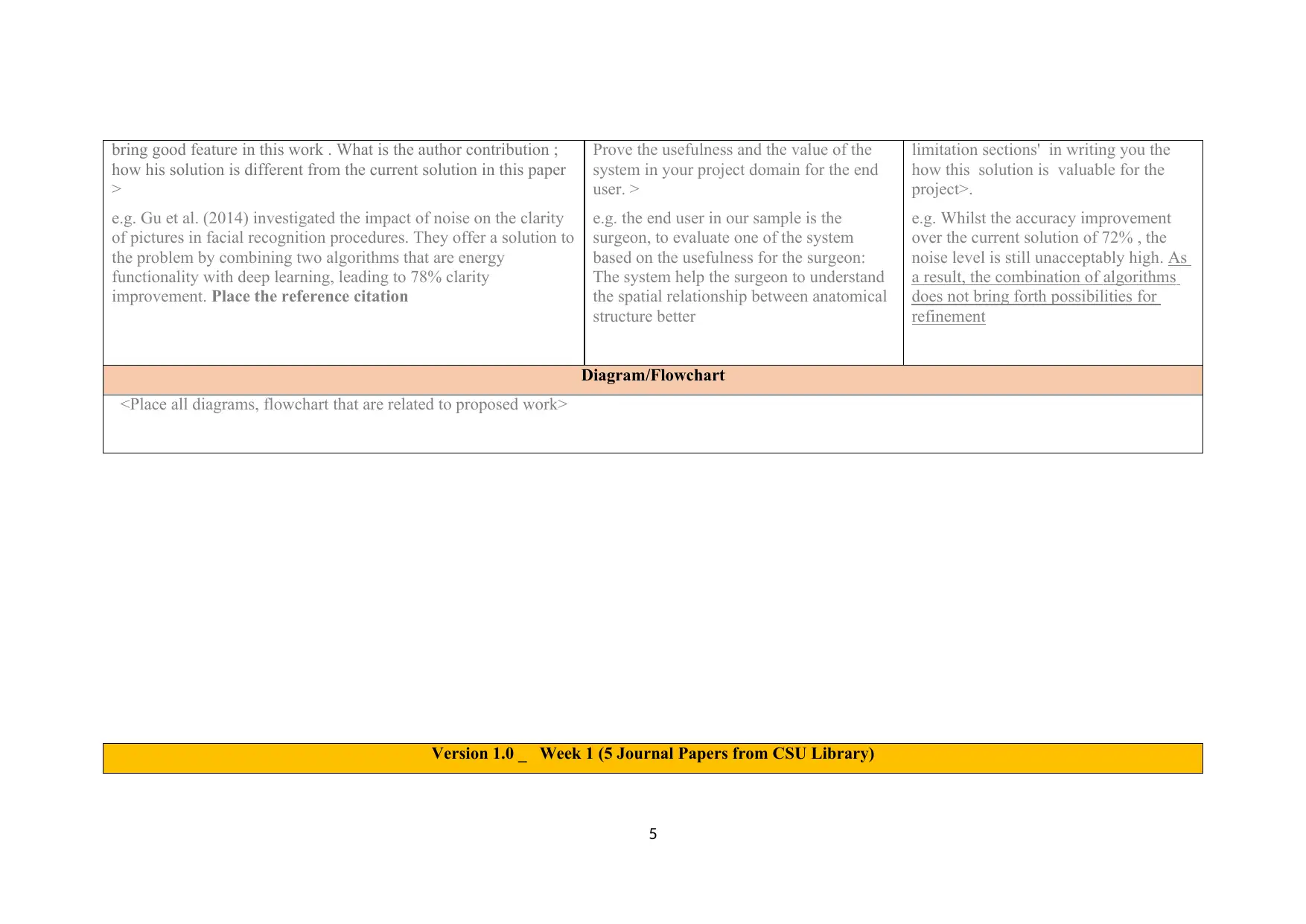
bring good feature in this work . What is the author contribution ;
how his solution is different from the current solution in this paper
>
e.g. Gu et al. (2014) investigated the impact of noise on the clarity
of pictures in facial recognition procedures. They offer a solution to
the problem by combining two algorithms that are energy
functionality with deep learning, leading to 78% clarity
improvement. Place the reference citation
Prove the usefulness and the value of the
system in your project domain for the end
user. >
e.g. the end user in our sample is the
surgeon, to evaluate one of the system
based on the usefulness for the surgeon:
The system help the surgeon to understand
the spatial relationship between anatomical
structure better
limitation sections' in writing you the
how this solution is valuable for the
project>.
e.g. Whilst the accuracy improvement
over the current solution of 72% , the
noise level is still unacceptably high. As
a result, the combination of algorithms
does not bring forth possibilities for
refinement
Diagram/Flowchart
<Place all diagrams, flowchart that are related to proposed work>
Version 1.0 _ Week 1 (5 Journal Papers from CSU Library)
5
how his solution is different from the current solution in this paper
>
e.g. Gu et al. (2014) investigated the impact of noise on the clarity
of pictures in facial recognition procedures. They offer a solution to
the problem by combining two algorithms that are energy
functionality with deep learning, leading to 78% clarity
improvement. Place the reference citation
Prove the usefulness and the value of the
system in your project domain for the end
user. >
e.g. the end user in our sample is the
surgeon, to evaluate one of the system
based on the usefulness for the surgeon:
The system help the surgeon to understand
the spatial relationship between anatomical
structure better
limitation sections' in writing you the
how this solution is valuable for the
project>.
e.g. Whilst the accuracy improvement
over the current solution of 72% , the
noise level is still unacceptably high. As
a result, the combination of algorithms
does not bring forth possibilities for
refinement
Diagram/Flowchart
<Place all diagrams, flowchart that are related to proposed work>
Version 1.0 _ Week 1 (5 Journal Papers from CSU Library)
5
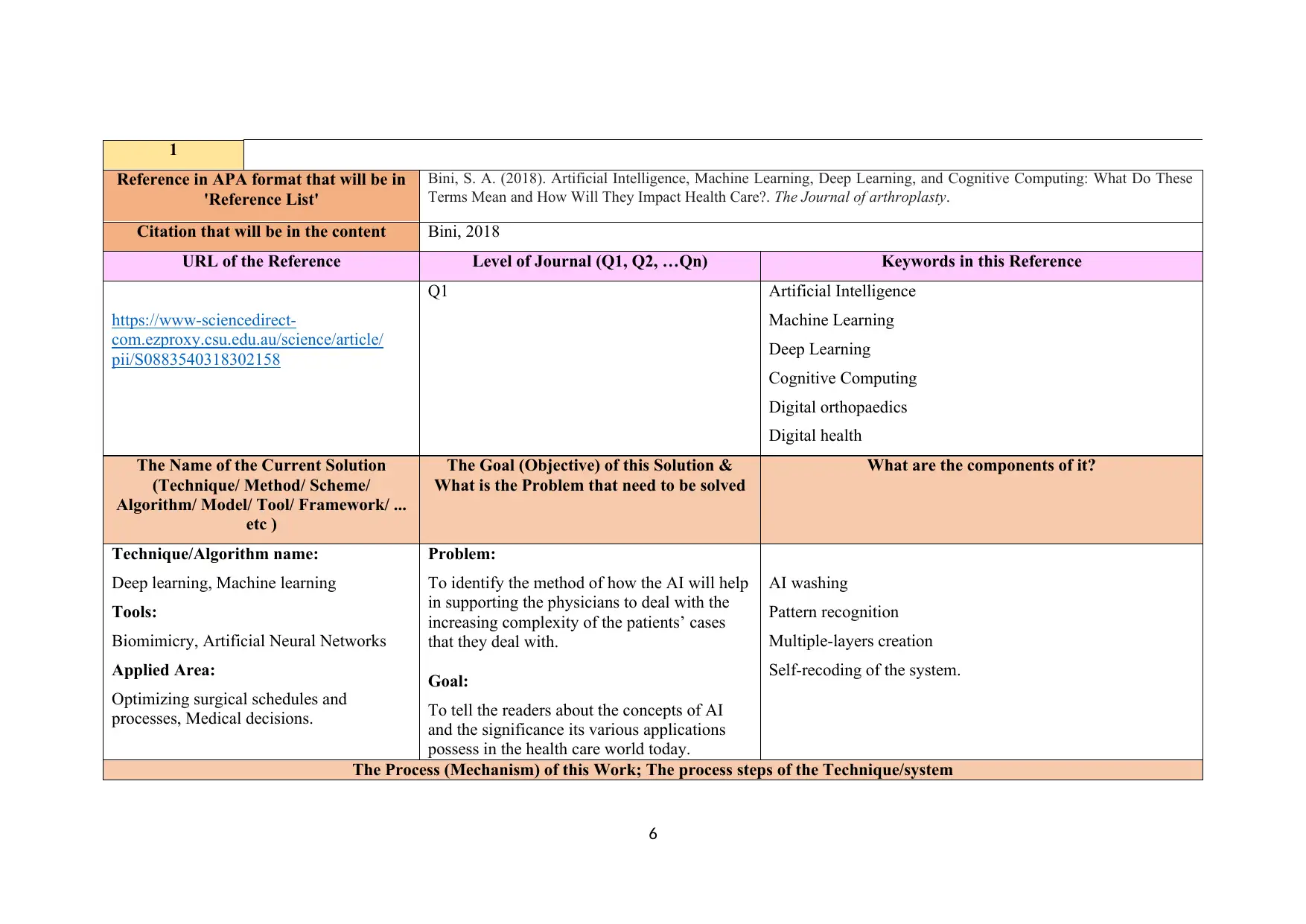
1
Reference in APA format that will be in
'Reference List'
Bini, S. A. (2018). Artificial Intelligence, Machine Learning, Deep Learning, and Cognitive Computing: What Do These
Terms Mean and How Will They Impact Health Care?. The Journal of arthroplasty.
Citation that will be in the content Bini, 2018
URL of the Reference Level of Journal (Q1, Q2, …Qn) Keywords in this Reference
https://www-sciencedirect-
com.ezproxy.csu.edu.au/science/article/
pii/S0883540318302158
Q1 Artificial Intelligence
Machine Learning
Deep Learning
Cognitive Computing
Digital orthopaedics
Digital health
The Name of the Current Solution
(Technique/ Method/ Scheme/
Algorithm/ Model/ Tool/ Framework/ ...
etc )
The Goal (Objective) of this Solution &
What is the Problem that need to be solved
What are the components of it?
Technique/Algorithm name:
Deep learning, Machine learning
Tools:
Biomimicry, Artificial Neural Networks
Applied Area:
Optimizing surgical schedules and
processes, Medical decisions.
Problem:
To identify the method of how the AI will help
in supporting the physicians to deal with the
increasing complexity of the patients’ cases
that they deal with.
Goal:
To tell the readers about the concepts of AI
and the significance its various applications
possess in the health care world today.
AI washing
Pattern recognition
Multiple-layers creation
Self-recoding of the system.
The Process (Mechanism) of this Work; The process steps of the Technique/system
6
Reference in APA format that will be in
'Reference List'
Bini, S. A. (2018). Artificial Intelligence, Machine Learning, Deep Learning, and Cognitive Computing: What Do These
Terms Mean and How Will They Impact Health Care?. The Journal of arthroplasty.
Citation that will be in the content Bini, 2018
URL of the Reference Level of Journal (Q1, Q2, …Qn) Keywords in this Reference
https://www-sciencedirect-
com.ezproxy.csu.edu.au/science/article/
pii/S0883540318302158
Q1 Artificial Intelligence
Machine Learning
Deep Learning
Cognitive Computing
Digital orthopaedics
Digital health
The Name of the Current Solution
(Technique/ Method/ Scheme/
Algorithm/ Model/ Tool/ Framework/ ...
etc )
The Goal (Objective) of this Solution &
What is the Problem that need to be solved
What are the components of it?
Technique/Algorithm name:
Deep learning, Machine learning
Tools:
Biomimicry, Artificial Neural Networks
Applied Area:
Optimizing surgical schedules and
processes, Medical decisions.
Problem:
To identify the method of how the AI will help
in supporting the physicians to deal with the
increasing complexity of the patients’ cases
that they deal with.
Goal:
To tell the readers about the concepts of AI
and the significance its various applications
possess in the health care world today.
AI washing
Pattern recognition
Multiple-layers creation
Self-recoding of the system.
The Process (Mechanism) of this Work; The process steps of the Technique/system
6
⊘ This is a preview!⊘
Do you want full access?
Subscribe today to unlock all pages.

Trusted by 1+ million students worldwide
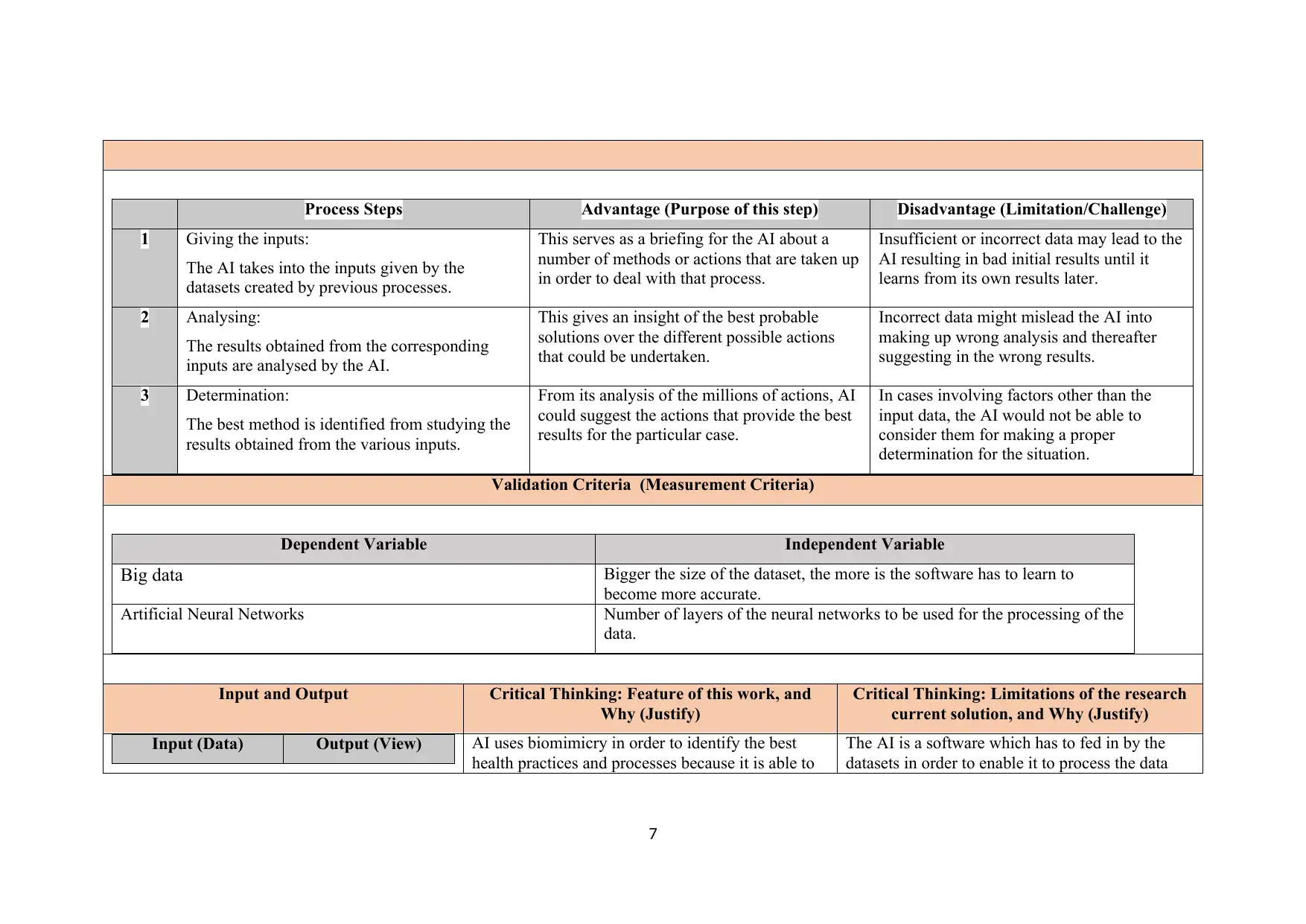
Process Steps Advantage (Purpose of this step) Disadvantage (Limitation/Challenge)
1 Giving the inputs:
The AI takes into the inputs given by the
datasets created by previous processes.
This serves as a briefing for the AI about a
number of methods or actions that are taken up
in order to deal with that process.
Insufficient or incorrect data may lead to the
AI resulting in bad initial results until it
learns from its own results later.
2 Analysing:
The results obtained from the corresponding
inputs are analysed by the AI.
This gives an insight of the best probable
solutions over the different possible actions
that could be undertaken.
Incorrect data might mislead the AI into
making up wrong analysis and thereafter
suggesting in the wrong results.
3 Determination:
The best method is identified from studying the
results obtained from the various inputs.
From its analysis of the millions of actions, AI
could suggest the actions that provide the best
results for the particular case.
In cases involving factors other than the
input data, the AI would not be able to
consider them for making a proper
determination for the situation.
Validation Criteria (Measurement Criteria)
Dependent Variable Independent Variable
Big data Bigger the size of the dataset, the more is the software has to learn to
become more accurate.
Artificial Neural Networks Number of layers of the neural networks to be used for the processing of the
data.
Input and Output Critical Thinking: Feature of this work, and
Why (Justify)
Critical Thinking: Limitations of the research
current solution, and Why (Justify)
Input (Data) Output (View) AI uses biomimicry in order to identify the best
health practices and processes because it is able to
The AI is a software which has to fed in by the
datasets in order to enable it to process the data
7
1 Giving the inputs:
The AI takes into the inputs given by the
datasets created by previous processes.
This serves as a briefing for the AI about a
number of methods or actions that are taken up
in order to deal with that process.
Insufficient or incorrect data may lead to the
AI resulting in bad initial results until it
learns from its own results later.
2 Analysing:
The results obtained from the corresponding
inputs are analysed by the AI.
This gives an insight of the best probable
solutions over the different possible actions
that could be undertaken.
Incorrect data might mislead the AI into
making up wrong analysis and thereafter
suggesting in the wrong results.
3 Determination:
The best method is identified from studying the
results obtained from the various inputs.
From its analysis of the millions of actions, AI
could suggest the actions that provide the best
results for the particular case.
In cases involving factors other than the
input data, the AI would not be able to
consider them for making a proper
determination for the situation.
Validation Criteria (Measurement Criteria)
Dependent Variable Independent Variable
Big data Bigger the size of the dataset, the more is the software has to learn to
become more accurate.
Artificial Neural Networks Number of layers of the neural networks to be used for the processing of the
data.
Input and Output Critical Thinking: Feature of this work, and
Why (Justify)
Critical Thinking: Limitations of the research
current solution, and Why (Justify)
Input (Data) Output (View) AI uses biomimicry in order to identify the best
health practices and processes because it is able to
The AI is a software which has to fed in by the
datasets in order to enable it to process the data
7
Paraphrase This Document
Need a fresh take? Get an instant paraphrase of this document with our AI Paraphraser
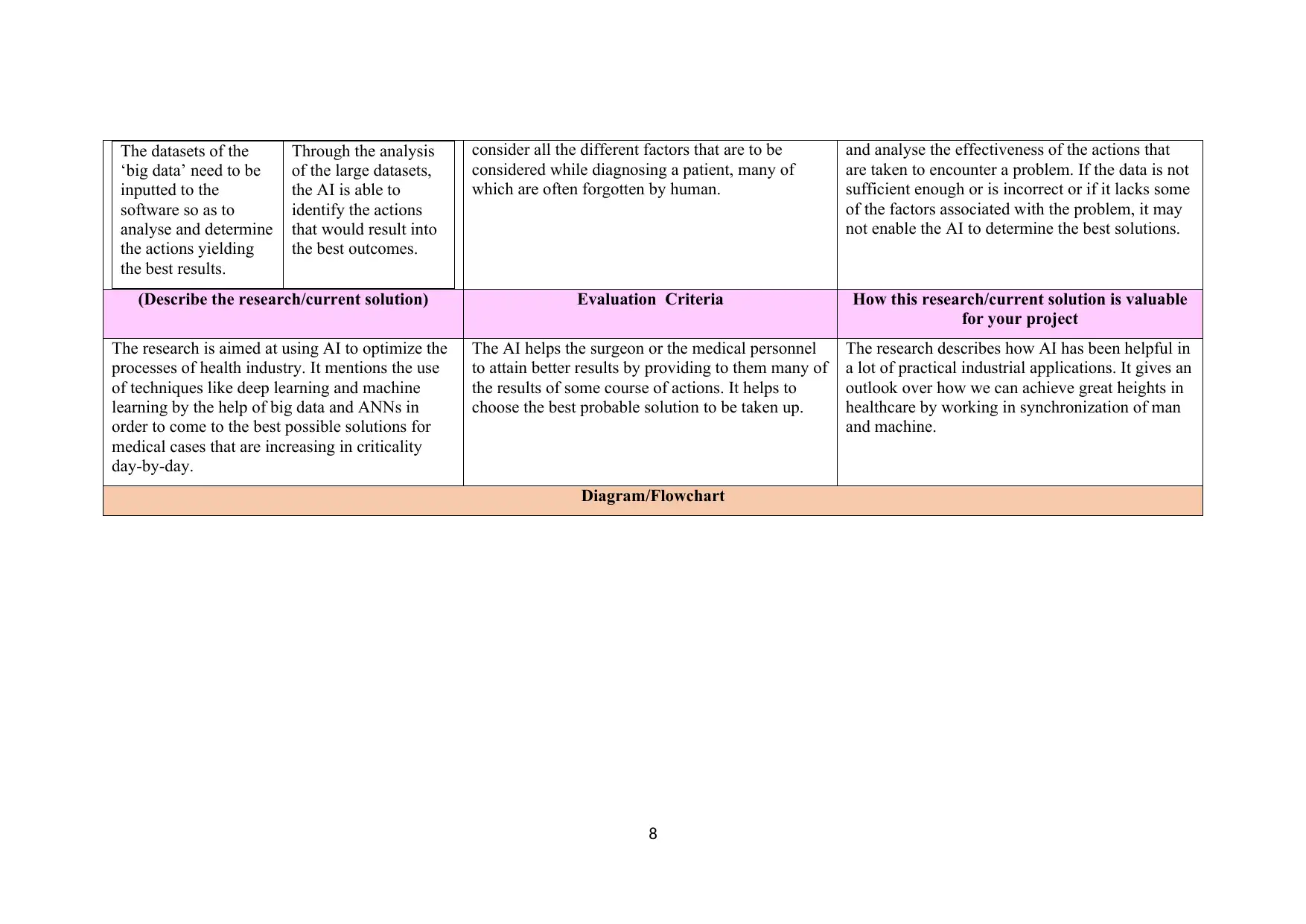
The datasets of the
‘big data’ need to be
inputted to the
software so as to
analyse and determine
the actions yielding
the best results.
Through the analysis
of the large datasets,
the AI is able to
identify the actions
that would result into
the best outcomes.
consider all the different factors that are to be
considered while diagnosing a patient, many of
which are often forgotten by human.
and analyse the effectiveness of the actions that
are taken to encounter a problem. If the data is not
sufficient enough or is incorrect or if it lacks some
of the factors associated with the problem, it may
not enable the AI to determine the best solutions.
(Describe the research/current solution) Evaluation Criteria How this research/current solution is valuable
for your project
The research is aimed at using AI to optimize the
processes of health industry. It mentions the use
of techniques like deep learning and machine
learning by the help of big data and ANNs in
order to come to the best possible solutions for
medical cases that are increasing in criticality
day-by-day.
The AI helps the surgeon or the medical personnel
to attain better results by providing to them many of
the results of some course of actions. It helps to
choose the best probable solution to be taken up.
The research describes how AI has been helpful in
a lot of practical industrial applications. It gives an
outlook over how we can achieve great heights in
healthcare by working in synchronization of man
and machine.
Diagram/Flowchart
8
‘big data’ need to be
inputted to the
software so as to
analyse and determine
the actions yielding
the best results.
Through the analysis
of the large datasets,
the AI is able to
identify the actions
that would result into
the best outcomes.
consider all the different factors that are to be
considered while diagnosing a patient, many of
which are often forgotten by human.
and analyse the effectiveness of the actions that
are taken to encounter a problem. If the data is not
sufficient enough or is incorrect or if it lacks some
of the factors associated with the problem, it may
not enable the AI to determine the best solutions.
(Describe the research/current solution) Evaluation Criteria How this research/current solution is valuable
for your project
The research is aimed at using AI to optimize the
processes of health industry. It mentions the use
of techniques like deep learning and machine
learning by the help of big data and ANNs in
order to come to the best possible solutions for
medical cases that are increasing in criticality
day-by-day.
The AI helps the surgeon or the medical personnel
to attain better results by providing to them many of
the results of some course of actions. It helps to
choose the best probable solution to be taken up.
The research describes how AI has been helpful in
a lot of practical industrial applications. It gives an
outlook over how we can achieve great heights in
healthcare by working in synchronization of man
and machine.
Diagram/Flowchart
8
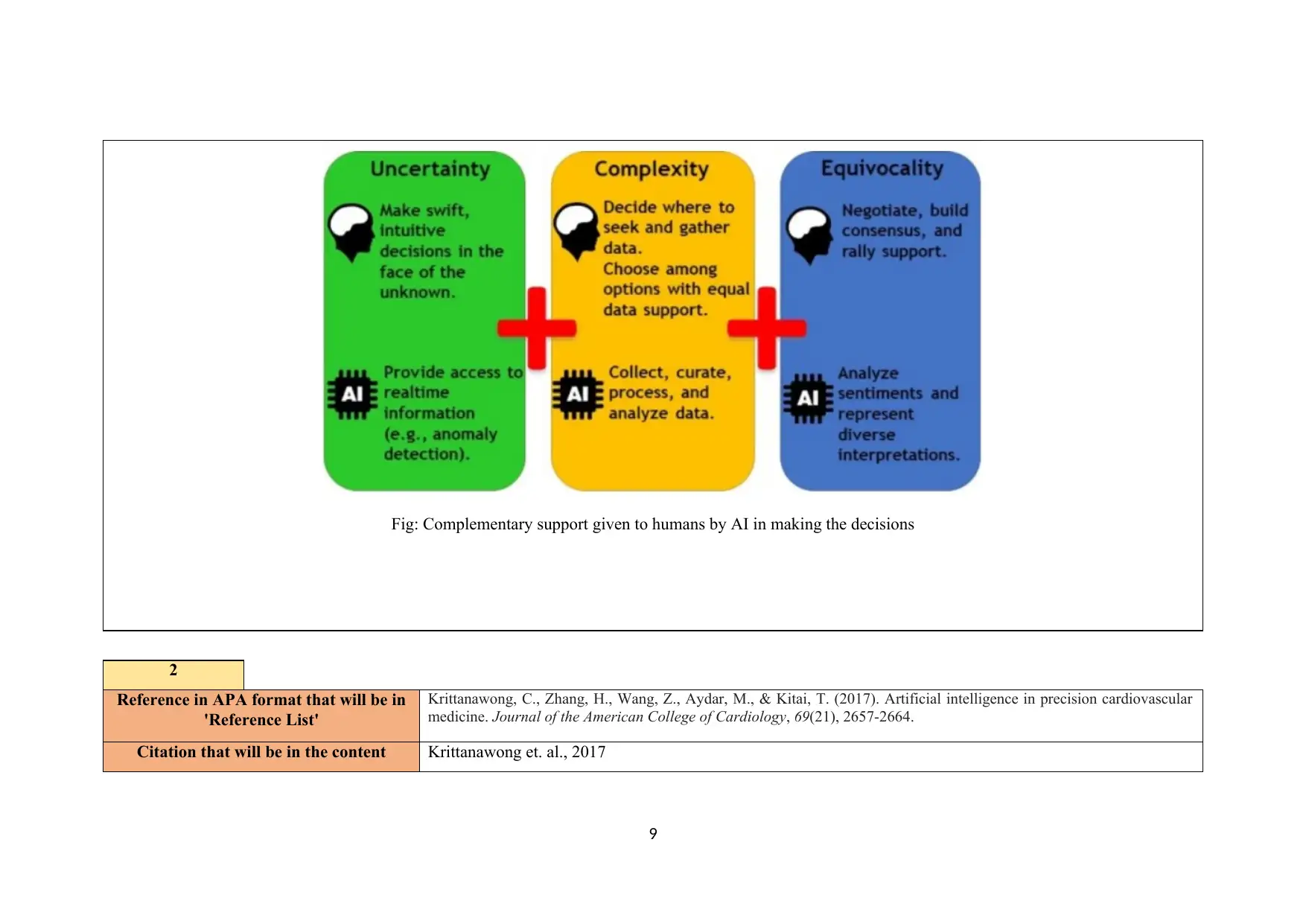
Fig: Complementary support given to humans by AI in making the decisions
2
Reference in APA format that will be in
'Reference List'
Krittanawong, C., Zhang, H., Wang, Z., Aydar, M., & Kitai, T. (2017). Artificial intelligence in precision cardiovascular
medicine. Journal of the American College of Cardiology, 69(21), 2657-2664.
Citation that will be in the content Krittanawong et. al., 2017
9
2
Reference in APA format that will be in
'Reference List'
Krittanawong, C., Zhang, H., Wang, Z., Aydar, M., & Kitai, T. (2017). Artificial intelligence in precision cardiovascular
medicine. Journal of the American College of Cardiology, 69(21), 2657-2664.
Citation that will be in the content Krittanawong et. al., 2017
9
⊘ This is a preview!⊘
Do you want full access?
Subscribe today to unlock all pages.

Trusted by 1+ million students worldwide
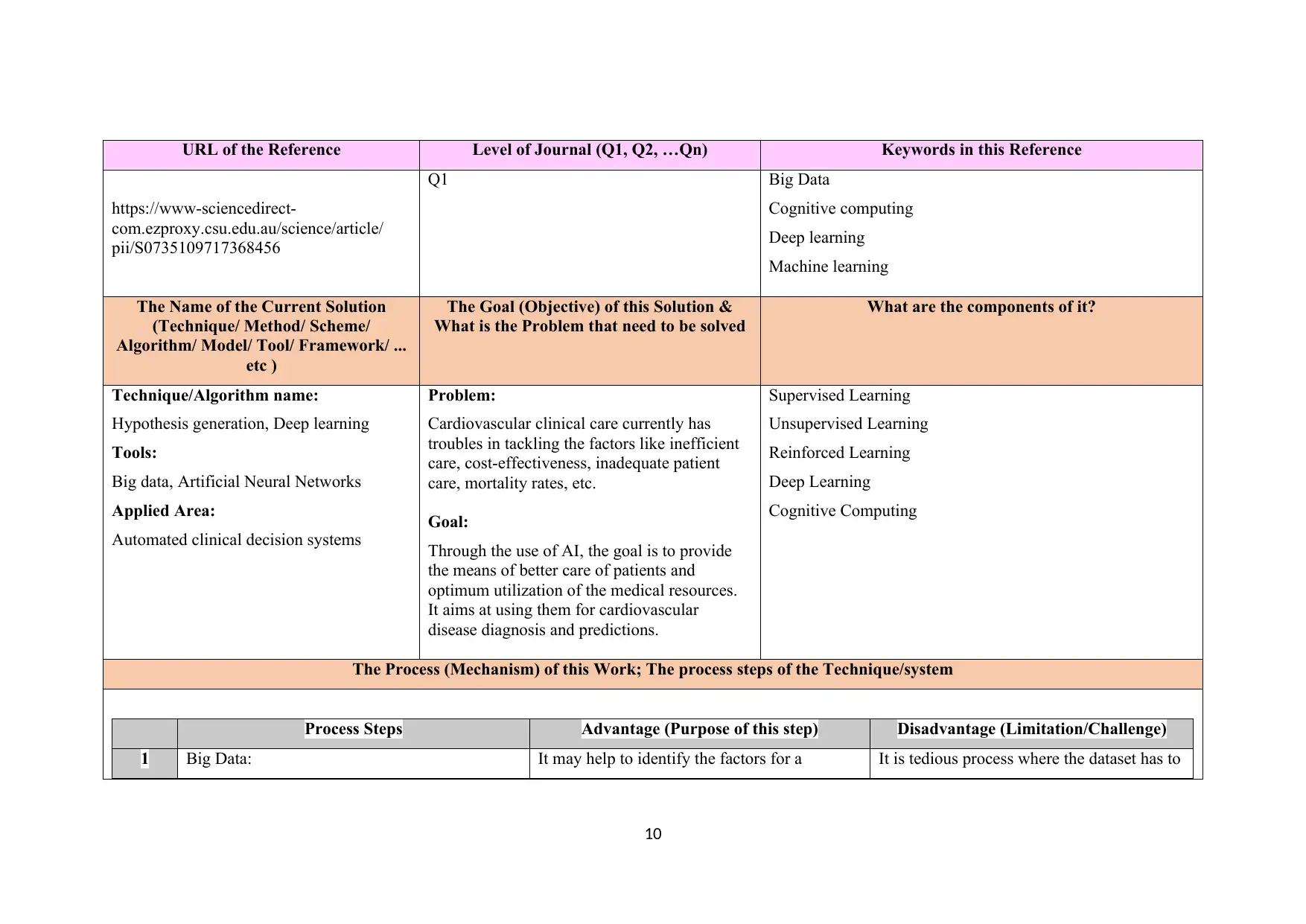
URL of the Reference Level of Journal (Q1, Q2, …Qn) Keywords in this Reference
https://www-sciencedirect-
com.ezproxy.csu.edu.au/science/article/
pii/S0735109717368456
Q1 Big Data
Cognitive computing
Deep learning
Machine learning
The Name of the Current Solution
(Technique/ Method/ Scheme/
Algorithm/ Model/ Tool/ Framework/ ...
etc )
The Goal (Objective) of this Solution &
What is the Problem that need to be solved
What are the components of it?
Technique/Algorithm name:
Hypothesis generation, Deep learning
Tools:
Big data, Artificial Neural Networks
Applied Area:
Automated clinical decision systems
Problem:
Cardiovascular clinical care currently has
troubles in tackling the factors like inefficient
care, cost-effectiveness, inadequate patient
care, mortality rates, etc.
Goal:
Through the use of AI, the goal is to provide
the means of better care of patients and
optimum utilization of the medical resources.
It aims at using them for cardiovascular
disease diagnosis and predictions.
Supervised Learning
Unsupervised Learning
Reinforced Learning
Deep Learning
Cognitive Computing
The Process (Mechanism) of this Work; The process steps of the Technique/system
Process Steps Advantage (Purpose of this step) Disadvantage (Limitation/Challenge)
1 Big Data: It may help to identify the factors for a It is tedious process where the dataset has to
10
https://www-sciencedirect-
com.ezproxy.csu.edu.au/science/article/
pii/S0735109717368456
Q1 Big Data
Cognitive computing
Deep learning
Machine learning
The Name of the Current Solution
(Technique/ Method/ Scheme/
Algorithm/ Model/ Tool/ Framework/ ...
etc )
The Goal (Objective) of this Solution &
What is the Problem that need to be solved
What are the components of it?
Technique/Algorithm name:
Hypothesis generation, Deep learning
Tools:
Big data, Artificial Neural Networks
Applied Area:
Automated clinical decision systems
Problem:
Cardiovascular clinical care currently has
troubles in tackling the factors like inefficient
care, cost-effectiveness, inadequate patient
care, mortality rates, etc.
Goal:
Through the use of AI, the goal is to provide
the means of better care of patients and
optimum utilization of the medical resources.
It aims at using them for cardiovascular
disease diagnosis and predictions.
Supervised Learning
Unsupervised Learning
Reinforced Learning
Deep Learning
Cognitive Computing
The Process (Mechanism) of this Work; The process steps of the Technique/system
Process Steps Advantage (Purpose of this step) Disadvantage (Limitation/Challenge)
1 Big Data: It may help to identify the factors for a It is tedious process where the dataset has to
10
Paraphrase This Document
Need a fresh take? Get an instant paraphrase of this document with our AI Paraphraser
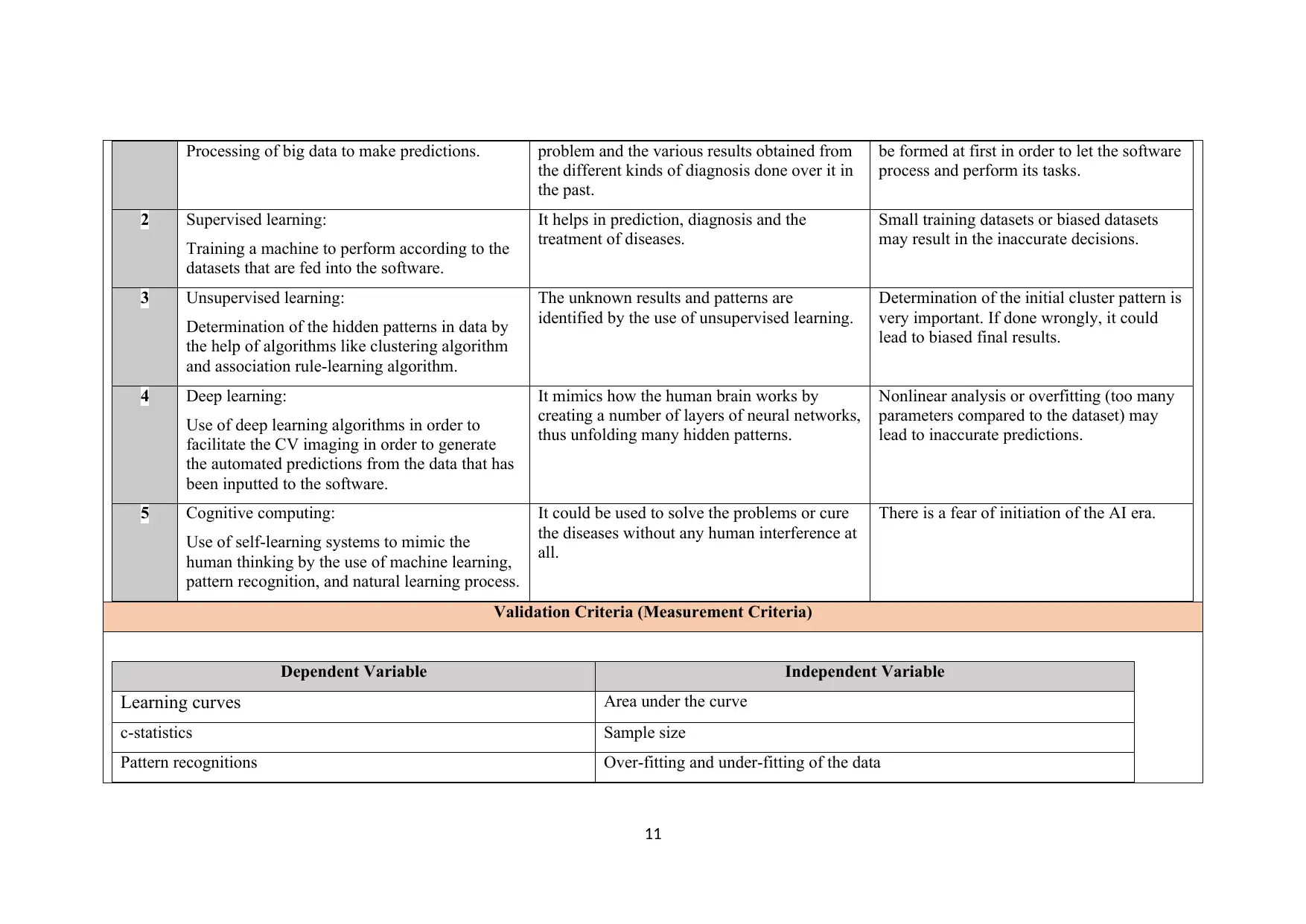
Processing of big data to make predictions. problem and the various results obtained from
the different kinds of diagnosis done over it in
the past.
be formed at first in order to let the software
process and perform its tasks.
2 Supervised learning:
Training a machine to perform according to the
datasets that are fed into the software.
It helps in prediction, diagnosis and the
treatment of diseases.
Small training datasets or biased datasets
may result in the inaccurate decisions.
3 Unsupervised learning:
Determination of the hidden patterns in data by
the help of algorithms like clustering algorithm
and association rule-learning algorithm.
The unknown results and patterns are
identified by the use of unsupervised learning.
Determination of the initial cluster pattern is
very important. If done wrongly, it could
lead to biased final results.
4 Deep learning:
Use of deep learning algorithms in order to
facilitate the CV imaging in order to generate
the automated predictions from the data that has
been inputted to the software.
It mimics how the human brain works by
creating a number of layers of neural networks,
thus unfolding many hidden patterns.
Nonlinear analysis or overfitting (too many
parameters compared to the dataset) may
lead to inaccurate predictions.
5 Cognitive computing:
Use of self-learning systems to mimic the
human thinking by the use of machine learning,
pattern recognition, and natural learning process.
It could be used to solve the problems or cure
the diseases without any human interference at
all.
There is a fear of initiation of the AI era.
Validation Criteria (Measurement Criteria)
Dependent Variable Independent Variable
Learning curves Area under the curve
c-statistics Sample size
Pattern recognitions Over-fitting and under-fitting of the data
11
the different kinds of diagnosis done over it in
the past.
be formed at first in order to let the software
process and perform its tasks.
2 Supervised learning:
Training a machine to perform according to the
datasets that are fed into the software.
It helps in prediction, diagnosis and the
treatment of diseases.
Small training datasets or biased datasets
may result in the inaccurate decisions.
3 Unsupervised learning:
Determination of the hidden patterns in data by
the help of algorithms like clustering algorithm
and association rule-learning algorithm.
The unknown results and patterns are
identified by the use of unsupervised learning.
Determination of the initial cluster pattern is
very important. If done wrongly, it could
lead to biased final results.
4 Deep learning:
Use of deep learning algorithms in order to
facilitate the CV imaging in order to generate
the automated predictions from the data that has
been inputted to the software.
It mimics how the human brain works by
creating a number of layers of neural networks,
thus unfolding many hidden patterns.
Nonlinear analysis or overfitting (too many
parameters compared to the dataset) may
lead to inaccurate predictions.
5 Cognitive computing:
Use of self-learning systems to mimic the
human thinking by the use of machine learning,
pattern recognition, and natural learning process.
It could be used to solve the problems or cure
the diseases without any human interference at
all.
There is a fear of initiation of the AI era.
Validation Criteria (Measurement Criteria)
Dependent Variable Independent Variable
Learning curves Area under the curve
c-statistics Sample size
Pattern recognitions Over-fitting and under-fitting of the data
11
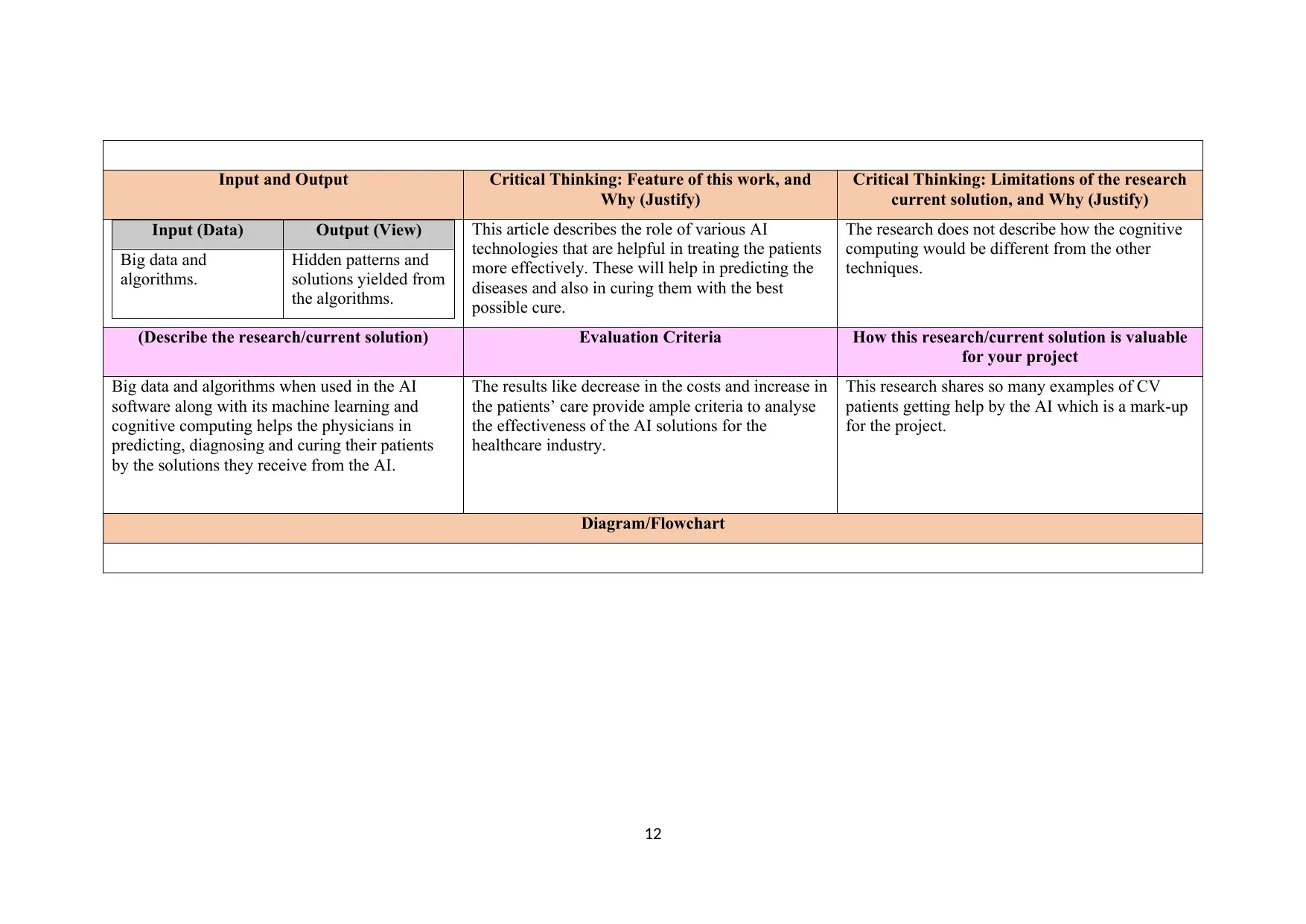
Input and Output Critical Thinking: Feature of this work, and
Why (Justify)
Critical Thinking: Limitations of the research
current solution, and Why (Justify)
Input (Data) Output (View)
Big data and
algorithms.
Hidden patterns and
solutions yielded from
the algorithms.
This article describes the role of various AI
technologies that are helpful in treating the patients
more effectively. These will help in predicting the
diseases and also in curing them with the best
possible cure.
The research does not describe how the cognitive
computing would be different from the other
techniques.
(Describe the research/current solution) Evaluation Criteria How this research/current solution is valuable
for your project
Big data and algorithms when used in the AI
software along with its machine learning and
cognitive computing helps the physicians in
predicting, diagnosing and curing their patients
by the solutions they receive from the AI.
The results like decrease in the costs and increase in
the patients’ care provide ample criteria to analyse
the effectiveness of the AI solutions for the
healthcare industry.
This research shares so many examples of CV
patients getting help by the AI which is a mark-up
for the project.
Diagram/Flowchart
12
Why (Justify)
Critical Thinking: Limitations of the research
current solution, and Why (Justify)
Input (Data) Output (View)
Big data and
algorithms.
Hidden patterns and
solutions yielded from
the algorithms.
This article describes the role of various AI
technologies that are helpful in treating the patients
more effectively. These will help in predicting the
diseases and also in curing them with the best
possible cure.
The research does not describe how the cognitive
computing would be different from the other
techniques.
(Describe the research/current solution) Evaluation Criteria How this research/current solution is valuable
for your project
Big data and algorithms when used in the AI
software along with its machine learning and
cognitive computing helps the physicians in
predicting, diagnosing and curing their patients
by the solutions they receive from the AI.
The results like decrease in the costs and increase in
the patients’ care provide ample criteria to analyse
the effectiveness of the AI solutions for the
healthcare industry.
This research shares so many examples of CV
patients getting help by the AI which is a mark-up
for the project.
Diagram/Flowchart
12
⊘ This is a preview!⊘
Do you want full access?
Subscribe today to unlock all pages.

Trusted by 1+ million students worldwide
1 out of 80
Related Documents
Your All-in-One AI-Powered Toolkit for Academic Success.
+13062052269
info@desklib.com
Available 24*7 on WhatsApp / Email
![[object Object]](/_next/static/media/star-bottom.7253800d.svg)
Unlock your academic potential
Copyright © 2020–2025 A2Z Services. All Rights Reserved. Developed and managed by ZUCOL.




